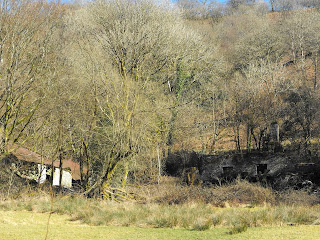 This picture of lichens was taken on my walk, when every step felt an effort! I have put the photo sideways so you can see the lichens more clearly, but it makes the hill look like a precipice!
This picture of lichens was taken on my walk, when every step felt an effort! I have put the photo sideways so you can see the lichens more clearly, but it makes the hill look like a precipice!I have been feeding the birds - I now have a cock Pheasant and three hens come to scavenge under the feeders. This one was reminding me it was feeding time!

I have seen a Cormorant on the tidal part of the River Towy, shaking his head after diving for fish . . . I have seen several Buzzards, a Red Kite, Herons on the Heronry down at Whitemill (they really do NOT look like tree-dwelling birds . . .), and the first frogspawn has appeared in our wildlife pond though it has sadly been a little frozen by the frost last night - much of it being above water, as you can see . . .

My menfolk have been putting up the newly-made cornice, though that has made fresh problems as the ceiling is so wonky and we have had to line up with the wall and the other cornice, rather than the ceiling, so slips of wood will have to be put in to hide the gaps (an inch over one end of the fireplace!) OH even had to make the dentil "teeth" for this length of the cornice, and I was very impressed by this!


Yet more x-stitch - I am on the half stitches of the church tower now, so that is coming along a bit faster. I can't wait to have it finished and then we can frame it.

And for the first time in many years I have been drawing again. Well, copying, as you can see. I was relieved I haven't completely forgotten how!

















































